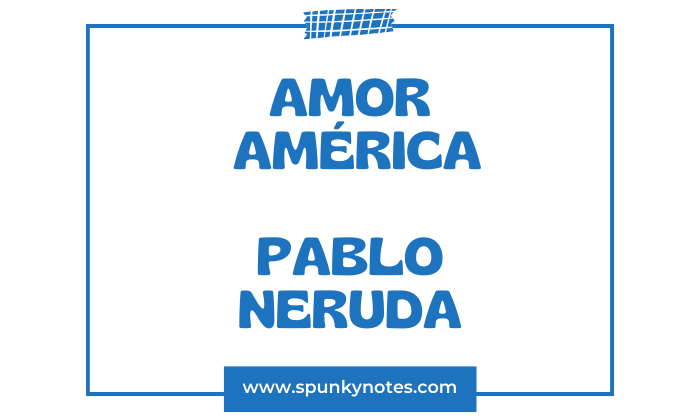

Estimated Reading Time: 12 min
Q. Explain the poem Amor América by Pablo Neruda.
“Canto General” is an epic poem by Chilean poet Pablo Neruda. Published in 1950, it is considered one of Neruda’s most significant works and a masterpiece of Latin American literature.
Canto General is divided into 15 sections (Canto) across two volumes and contains over 300 poems.
- La lámpara en la tierra (The Lamp on Earth)
Contains “Amor América (1400)” (Love America). - Las alturas de Macchu Picchu (The Heights of Macchu Picchu)
- Los conquistadores (The Conquistadors)
- Los libertadores (The Liberators)
- La arena traicionada (The Sand Betrayed)
Contains “The Hangman” (El verdugo). - América, no invoco tu nombre en vano (America, I Do Not Invoke Your Name in Vain)
- El estrecho dudoso (The Uncertain Strait)
- Canto general de Chile (General Song of Chile)
- La tierra se llama Juan (The Earth is Called Juan)
- Que despierte el leñador (Let the Woodcutter Awaken)
- Las flores de Punitaqui (The Flowers of Punitaqui)
- Los ríos del canto (The Rivers of Song)
- Coral de año nuevo para la patria en tinieblas (New Year’s Song of the Nation in Darkness)
Contains “You Will Fight” (Lucharás) as the 16th poem. - El gran océano (The Great Ocean)
- Yo soy (I Am)
“Amor América” by Pablo Neruda is written in Spanish and is part of his collection “Canto General,” published in 1950. This extensive collection includes more than 200 poems that examine Latin America’s history, culture, and natural environment.
The poems in “Canto General” address various topics, from the struggles and identities of Latin American people to the appreciation of its landscapes.
“Amor América” specifically reflects on the history of the Americas before the arrival of Europeans, highlighting the beauty of the land and the impact of colonization. Pablo Neruda shows the pre-colonial Americas, emphasizing its untouched beauty and natural grandeur.
Explanation of Love America
translated by Mikaela Dunitz
Stanza 1
Before the wig and coat
were the rivers, the arterial rivers,
the mountain ranges, in whose weary wave
the condor or the snow appeared unstirring:
the thickness of the humidity, the unnamed
thunderclap, the planetary pampas.
Before the wig and coat
This line immediately sets a contrast between the pre-colonial Americas and the period of European colonization. The “wig and coat” symbolize the European colonizers and their societal norms, suggesting a time before their arrival and influence.
Were the rivers, the arterial rivers,
Neruda describes the rivers as “arterial,” comparing them to arteries carrying blood. This metaphor highlights the rivers’ crucial role in sustaining life and nourishing the land, emphasizing their importance to the continent’s ecosystem.
The mountain ranges, in whose weary wave
The mountains are personified with a “weary wave,” suggesting their ancient and enduring presence. This evokes a sense of timelessness and stability, indicating that the mountains have witnessed countless generations and changes.
The condor or the snow appeared unstirring
The condor, a majestic bird significant in many South American cultures, and the snow are described as “unstirring.” This conveys a sense of stillness and permanence, highlighting the timeless and unchanging nature of the landscape.
The thickness of the humidity, the unnamed
By referring to the “thickness of the humidity,” Neruda evokes the dense, palpable air typical of many regions in the Americas. The “unnamed” suggests a pristine world, untouched by human interference and not yet categorized or altered by civilization.
Thunderclap, the planetary pampas.
The “thunderclap” adds an element of raw, natural power to the scene, emphasizing the formidable forces of nature. Describing the pampas as “planetary” underscores their vastness and significance, presenting them as a fundamental part of the Earth’s landscape.
The term “pampas” specifically refers to the extensive, fertile lowlands found primarily in Argentina but also extending into Uruguay and Brazil.
These plains are characterized by their vast, flat or gently undulating terrain, covered largely by tall grasses and, historically, home to diverse wildlife.
Stanza 2
Man was earth, a vessel, the eyelid
of the quivering clay, a form from the mud of the earth,
a Carib pitcher, a chibcha stone,
an imperial chalice or an Araucanian silica.
Tender and bleeding he was, but on the hilt
of his moist crystal weapon,
the initials of the earth were
inscribed.
No one could remember them later: the wind
forgot them, the language of the water
interred, the keys were lost
or inundated by silence or blood.
In this section of Pablo Neruda’s “Amor América,” the poet discusses the close relationship between humans and the earth. It focuses on indigenous cultures and how their traditions have been lost over time.
Man was earth, a vessel, the eyelid
of the quivering clay, a form from the mud of the earth
Neruda says humans are part of the earth and are made from its substance. He shows a closeness with the earth, comparing humans to containers or covers made of living clay, highlighting our origin and connection with nature.
a Carib pitcher, a chibcha stone,
an imperial chalice or an Araucanian silica
These objects from different indigenous groups show the diversity and cultural richness of the Americas before European contact. Each item represents the unique cultural identities of the continent’s heritage.
Carib pitcher
The Carib people lived in the Caribbean. They made pottery, such as pitchers, to store and serve liquids. These pitchers show the Carib people’s skill in making useful and beautiful items.
Chibcha stone
The Chibcha (or Muisca) lived in Colombia. They created stone objects for ceremonies, tools, or carvings. These stones highlight their expertise in working with stone and their rich culture.
Imperial chalice
This refers to a special cup used by the Inca people, who had a powerful empire in South America. The chalice would have been used in important rituals, showing the Inca’s advanced skills in making beautiful metal objects.
Araucanian silica
The Araucanians, also known as the Mapuche, lived in parts of Chile and Argentina. They made tools and items from silica, a type of mineral. These objects show the Mapuche’s resourcefulness and their connection to the land.
Tender and bleeding he was, but on the hilt
of his moist crystal weapon,
the initials of the earth were inscribed
This shows humans as vulnerable but important, using tools made from natural resources. The ‘initials of the earth’ on the tool suggest a special purpose, connecting human actions directly to the earth.
No one could remember them later: the wind
forgot them, the language of the
water interred, the keys were lost
or inundated by silence or blood
Neruda talks about how indigenous knowledge and traditions were erased. He describes how the original languages and practices were forgotten by nature and buried after colonization.
The ‘silence or blood’ suggests both neglect and violent suppression. Neruda mourns the loss of indigenous cultures and their deep connection with the environment.
Stanza 3
Life was not lost, pastoral brothers.
But as a savagé rose,
a red drop fell to the depths,
and the lamp of the land was extinguished.
I am here to tell history.
Since the peace of the buffalo
until the lashed sands
of final earth, in the accumulated surf
of antarctic light,
and for the burrows embedded off the cliffs
of somber Venezuelan peace,
I searched for you, my father,
young soldier of shadows and brass,
or you, nuptial plant, indomitable hair,
caiman mother, metallic dove.
Life was not lost, pastoral brothers
This line assures that despite the transformations and disruptions witnessed, the essence of life on the continent remains.
“Pastoral brothers” suggests an original state of harmony with nature, implying a peaceful rural existence. This can be the indigenous peoples or rural inhabitants who have a direct and symbiotic relationship with nature.
But as a savagé rose,
a red drop fell to the depths,
and the lamp of the land was extinguished.
But as a savagé rose
The phrase “savagé rose” combines contrasting images to symbolize a sudden and violent rise of conflict or aggression. Typically, a rose represents beauty and delicacy.
However, paired with the word “savagé,” it creates a striking image of beauty mixed with brutality. This suggests a force that is both destructive and captivating, embodying both allure and danger.
A red drop fell to the depths
The “red drop” likely symbolizes blood, a common emblem of violence and sacrifice. The idea of it falling “to the depths” suggests a deep, possibly irreversible loss.
This part of the line conveys the impact of violence or conflict, indicating that it reaches deep into the foundation of society or land and profoundly affects it.
The lamp of the land was extinguished
The “lamp of the land” metaphorically represents the guiding light or spirit of the land, which includes its cultural, spiritual, and perhaps ecological vitality.
“Extinguished” implies that the conflict not only caused immediate damage but also led to a loss of guidance, hope, or life force within the land.
I am here to tell history.
The poet declares his role as a narrator, tasked with recounting the historical events that have shaped the continent. This line underscores the importance of documenting and remembering the past.
Since the peace of the buffalo
until the lashed sands
of final earth, in the accumulated surf
of antarctic light,
Neruda describes the timeline from peaceful times symbolized by buffalo to harsher periods shown as “lashed sands.” The “accumulated surf of antarctic light” could refer to remote or cold, distant impacts of history.
and for the burrows embedded off the cliffs
of somber Venezuelan peace,
This part extends the geographic scope to Venezuela, where he describes the peace as “sombre,” possibly indicating an uneasy peace shaped by previous conflicts.
I searched for you, my father,
young soldier of shadows and brass,
or you, nuptial plant, indomitable hair,
caiman mother, metallic dove.
In the closing lines, Neruda describes searching for various symbolic figures representing different elements of the continent’s character.
These figures range from a young soldier, symbolizing the continent’s turbulent military past, to natural and resilient images like a “nuptial plant” and “indomitable hair,” showing the beauty and toughness of the land.
Stanza 4
I, Inca from mud,
touched the stone and said:
Who waits for me?
And I squeezed my hand
around a fistful of empty glass.
But I traveled among zapotec flowers
and the light was as gentle as a stag,
and the shade was like a green eyelid.
I, Inca from mud,
Neruda identifies himself with the Inca civilization, which has a strong connection to the earth and remarkable achievements in architecture and agriculture.
The reference to “mud” emphasizes a fundamental, organic link to the earth, suggesting that he is not only descended from the Incas but also made from the same elemental materials as their famous structures and lands.
Touched the stone and said:
Who waits for me?
By touching the stone, a key element in Inca architecture, Neruda symbolizes reaching out to his history and ancestors. The question “Who waits for me?” reflects a deep existential inquiry, seeking a connection with past generations or pondering the legacy left for future ones.
And I squeezed my hand
around a fistful of empty glass.
This line represents grasping for something lost or elusive. Unlike the enduring stone, Glass symbolizes fragility and the brittle nature of modern connections compared to the lasting ties of historical ones.
But I traveled among zapotec flowers
The journey through “zapotec flowers” invokes the Zapotec people of Mexico, known for their rich culture and symbolic use of flowers in art and rituals.
Travelling among these flowers suggests moving through a landscape rich with history, cultural memory, and natural beauty.
and the light was as gentle as a stag,
Describing the light as “gentle as a stag” evokes a scene of natural grace and tranquillity. Stags symbolize gentleness, nobility, and the untamed wild, enhancing the serene tone of his exploration.
the shade was like a green eyelid.
The “green eyelid” imagery suggests a comforting and protective presence as if the land itself is watching over and sheltering the speaker. This personifies the landscape as almost sentient, providing a sense of solace and safety.
Stanza 5
My earth without a name, without America,
equinoctial stamen, purple spear,
your aroma winds up my roots
into the chalice I nursed, into the finest
word still not yet born from my mouth.
My earth without a name, without America,
Neruda starts by referring to the land as “My earth without a name, without America,” indicating a relationship with the land that predates colonial names and boundaries. This suggests a pure and ancient connection to the earth.
equinoctial stamen, purple spear,
He describes the land’s natural features using botanical terms. “Equinoctial stamen” refers to the fertile and vibrant areas near the equator, while “purple spear” might represent the striking and beautiful aspects of the land, as well as its strength and resilience.
your aroma winds up my roots
This line shows how deeply the poet feels connected to his land. The scent of the earth nurtures his roots, symbolizing his deep-seated identity and connection to the land.
into the chalice I nursed,
into the finest word
The “chalice” might symbolize the poet’s soul or creative spirit. It suggests that his inspiration and sustenance come from the natural world around him.
still not yet born from my mouth.
This line suggests that the land continues to inspire new thoughts and creations that are yet to be expressed. It indicates that the poet’s connection with the land is ongoing, always providing new ideas and artistic output.


